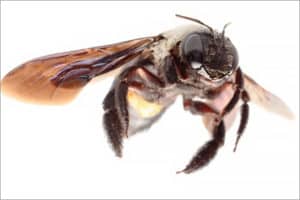
Carpenter Bee Control Services
If it is that time of the year, Carpenter Bees can drive you nuts! Many people declare war on these insects by getting their tennis racquets out and swinging away! However, we have less physically combative options, when it comes to controlling a Carpenter Bee infestation. No matter your situation, we can help get rid of these carpenter bees!
Carpenter bees are large, solitary bees that resemble bumblebees. Unlike honeybees, carpenter bees do not live in hives or colonies. Instead, they prefer to make their nests in wood, such as eaves, decks, and other outdoor wooden structures. They can cause significant damage to wooden structures. They bore perfectly round holes into the wood, which can weaken the structure and make it more vulnerable to water damage and decay. Additionally, carpenter bee nests can attract woodpeckers, who may further damage the wood to feed on the bees. So if you notice large, black bees flying around your property, you may have a carpenter bee infestation. Look for perfectly round holes in wooden structures, as well as sawdust or other debris near the holes. You may also hear buzzing or clicking sounds coming from the wood.
If you suspect a carpenter bee infestation on your property, do not hesitate to contact us, we offer effective carpenter bee control services to help eliminate infestations and prevent future damage for an affordable price.
OUR ANNUAL CARPENTER BEE PROGRAM
We offer an aggressive & highly effective Carpenter Bee Control program. We come out and install several Carpenter Bee traps that are locally custom made to our specifications. We strategically place these traps in areas that need the most attention. We fill hole in the immediate area, only the holes that are in direct competition with our traps to make our traps more desirable. We bait the traps with visual bait & scent to attract the bees.
Each year right before Spring we automatically come back to service the traps. We assess the location to make sure they are in the best position. We sand, clean up and possibly replace any traps that need to be replaced. We bait the traps with both visual & scent to attract the bees again and do this process every year.
Our Annual Carpenter Bee Control program has been thoroughly tested over 14 years and has proven to be one of the most effective programs we have. We install and maintain the traps, so you do not have to worry about them at all.
Call us to get started: (678)935-5900
CARPENTER BEE FAQ’s:
Q: What is a carpenter bee?
A: Carpenter bees are a solitary bee species that can be overwhelming in the State of Georgia. They bore holes in bare, unpainted softwoods to lay their eggs in and nest in over the winter months. Contrary to popular belief, they do not eat the wood. They consume pollen.
Q: What do they look like?
A: They are a large species of bee (pictured above), that can grow in length from ½ an inch to 1 ½ inches in length. They are often mistaken for bumble bees, but do not have a hairy abdomen. Their belly is black and shiny.
Q: Do carpenter bees sting?
A: Carpenter bees typically do not sting or bite. The female does have a stinger but will only sting if directly handled; the female is not generally aggressive.
Because they can sting there is a possibility that a person could have a mild or severe allergic reaction from their sting. Medical attention may be necessary if stung by a carpenter bee.
Q: What are the signs of a carpenter bee problem?
A: There are many signs that you may notice if carpenter bees are present on your property including: Holes that are about ½ of an inch in diameter in wood that is unfinished, weathered or bare, Piles of sawdust under the holes, Males are aggressive and will protect their nest, so you will see them flying around the holes, and there may be yellow staining from their fecal matter underneath the hole.
Q: Why do I have a Carpenter Bee problem?
A: Since Carpenter bees are attracted to unpainted, unstained, weathered softwoods a simple way to prevent this is to paint or stain softwoods or avoid soft wood in general.
Q: How do I get rid of carpenter bees?
A: The problem with carpenter bees is that they will often come back to the same place year after year to nest and can create enough holes and tunnels to weaken the structure of your home. We have both chemical-free measures we can implement as well as standard residual pesticide application & exclusion measures. Call us we can help!
Q: How can I prevent them?
A: Since carpenter bees do not like creating holes in treated wood, painting or staining your decks, porch or shed is a good way to prevent them. Also building your structure out of hard wood instead of softwood is a good way to deter them from using your property as a nesting spot. Keep in mind there is no guarantee that any measures will 100% end the problem. But every step taken to prevent – helps!
